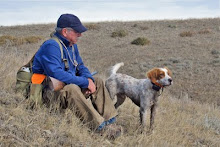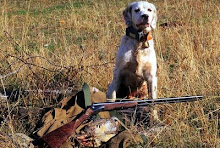
Let me start by saying that I am not a great fan of Orvis. Having read most of what is available on the subject of shotguns and shooting I have found some texts that are very helpful in the practical application of technique for the upland bird hunter, and many, many that did not, or could not, distinguish between target shooting (trap, skeet, sporting clays) and the needs of the upland bird hunter. The Orvis Wing-Shooting Handbook does.
Looking for something to read last night I picked Bowlen's book from the shelf and re-read mytattered copy. Bruce Bowlen has a structured, simple approach that most bird hunters will find useful - especially those that, like me, like to carry a lightweight doublegun.
In the early 90s I abandoned International Skeet and clays. I sold my heavy O/U target guns. I wanted to learn to shoot a light game gun well, and could not make adequate progress using the techniques that worked (mostly) for me when shooting targets in competition. I struggled to figure out how to effectively shoot a sub six pound SxS gun. Since a friend and fellow shooter,
Jon Ogilvie, offered high level instruction, I also turned to him for help. After a period of years (I must be a slow learner) I evolved a personal style (a jumble of Move-Mount-Shoot and instinctive techniques) that allows me to shoot lightweight double guns reasonably well in most any field situation. I still have my off days, but I now have confidence that any bird in range is at risk.
If I had read Bowlen's book when I started in shooting truly lightweight guns at game birds in the early 80s, I would have suffered much less pain, sweat, cartridges, and embarrassment. Bruce writes clearly and lays out a clear, step-by-step method uncluttered by anecdote or self aggrandizement. This is a welcome relief from the run of the mill 'outdoor writer' for which I am very grateful. I recommend this book for any upland gunner, even one who has already figured most of it out.
I also recommend a text by a pair of Brits, Shotgun Marksmanship by Percy Stanbury and G.L. Carlisle. This requires wading through the 'whilsts' and 'one musts' to get to the meat, but it is good.











